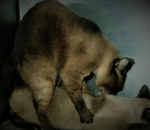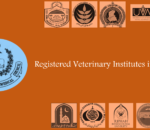Ephemeral fever is an acute arthropod-borne, noncontagious, viral disease of Cattle and Water Buffalo reported from Africa, the Middle East, Australia, and Asia. Ephemeral fever is also known as Three Day Sickness. Bovine Ephemeral Fever in cattle is caused by a bovine ephemeral fever virus (BEFV) that belongs to the family Rhabdoviridae and the genus Ephemerovirus. This BEFV is a single-stranded, negative-sense RNA virus.
BEFV can be transmitted from infected animals to susceptible cattle by IV inoculation; as little as 0.005 mL of blood collected during the febrile stage is infective. This virus is not transmitted by direct contact or through fomites.
Bovine ephemeral fever is most prevalent in the rainy season (when conditions favor the multiplication of biting insects). It is not seen in the winter season. Morbidity is high as 80% while mortality is usually 1-2 %. Bulls, heavy cattle, and high lactating dairy cows are the most severely affected, but spontaneous recovery usually occurs within a few days (that’s why called Three Day Sickness).
.
Clinical Signs of Ephemeral Fever
- High polyphasic fever (104–107.6°F)
- Muscular shivering
- Dull and depressed animal in standing position
- Stiffness of the limbs
- Lameness
- Lacrimation
- Serous nasal discharge
- Drooling
- Enlargement of lymph node
- Respiratory distress
- Anorexia
- Definitely animal have hypocalcemia
- Occasionally diarrhea
- Congested mucus membrane
- Sudden decrease in milk yield
Diagnosis
- Diagnosis is almost entirely based on clinical signs in an epidemic.
- Laboratory confirmation is by:
- Serology
- Virus isolation
- Blocking ELISA and neutralization test are also used for antibody detection.
- Paired sera collected 2–3 weeks apart is used to confirm the infection. A 4-fold rise in antibody titer confirms infection.
- The lesions include polyserositis affecting pleural, pericardial, and peritoneal surfaces;
- Serofibrinous polysynovitis, polyarthritis, polytendinitis, and cellulitis; and focal necrosis of skeletal muscles.
- Generalized edema of lymph nodes and lungs, as well as atelectasis (collapse of an expanded lung), also may be present.
Line of treatment :
- Provide complete rest to the animal, and recovering animals should be saved from stress or hard work because relapse is likely.
- Non-steroidal anti-inflammatory
- Flunixin meglumine – 1.1-2.2mg/kg (I/M)
- Use of Antibiotics
- Enrofloxacin 7.5-12.5mg/kg (I/M)
- Chlorpheniramine maleate 0.25-0.5 mg/kg (I/M)
- Fluid therapy ( RL/NS/DNS/D20) – I/V
- Hypocalcemia will be treated as for milk fever. (Calcium borogluconate – 1g/45kg – I/V)
NOTE: Generally without treatment animals recover within 3 days.
Caution: Avoid oral drenching – because the susceptible animal did not have swallowing ability.


